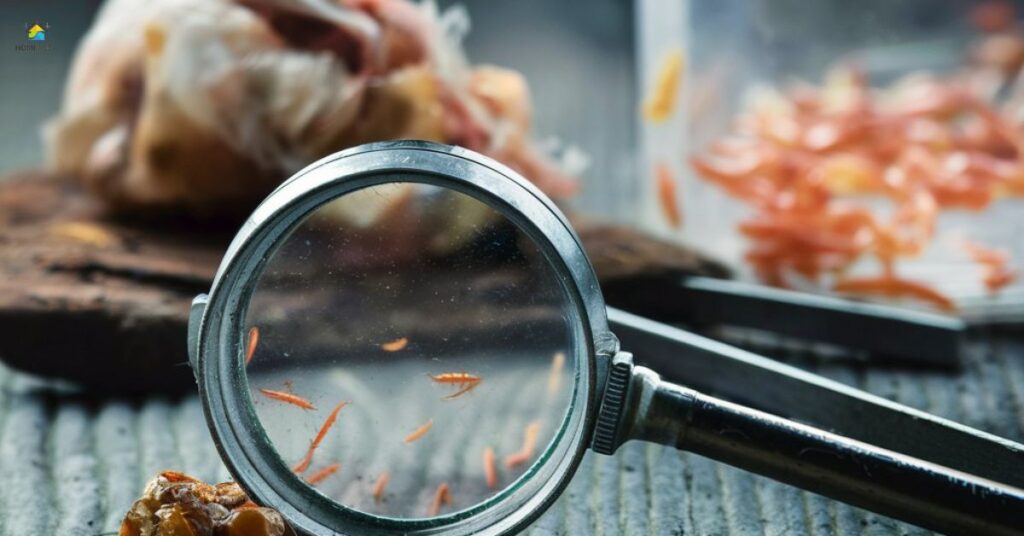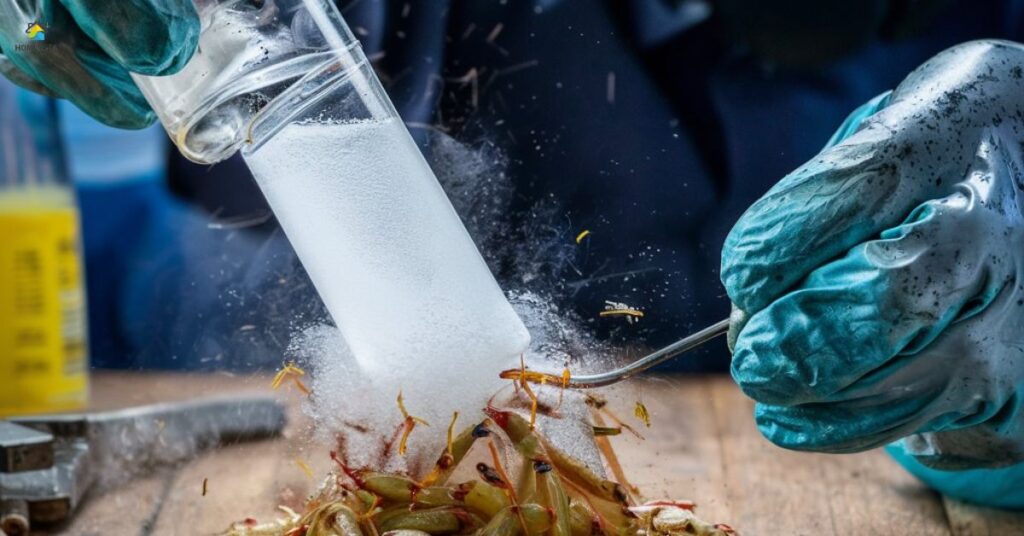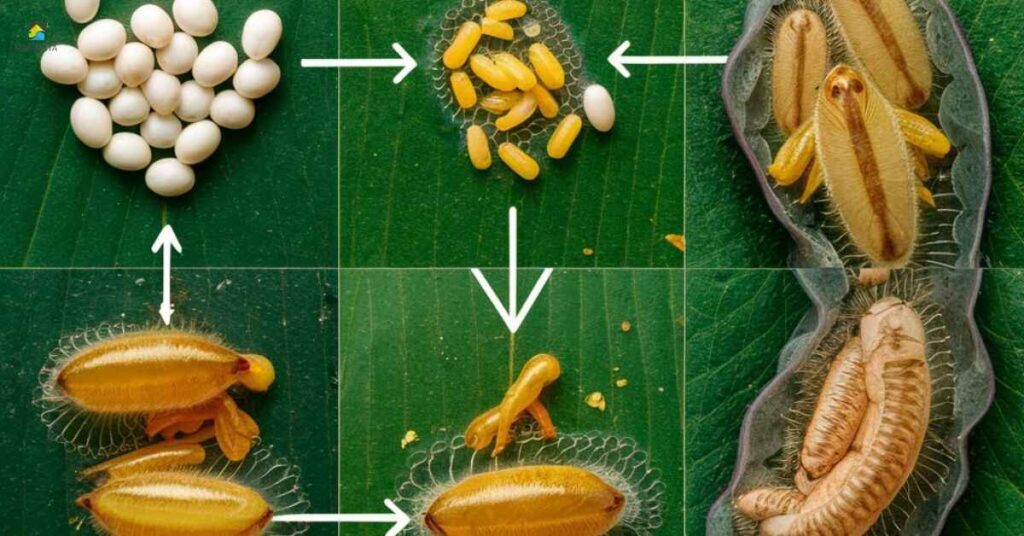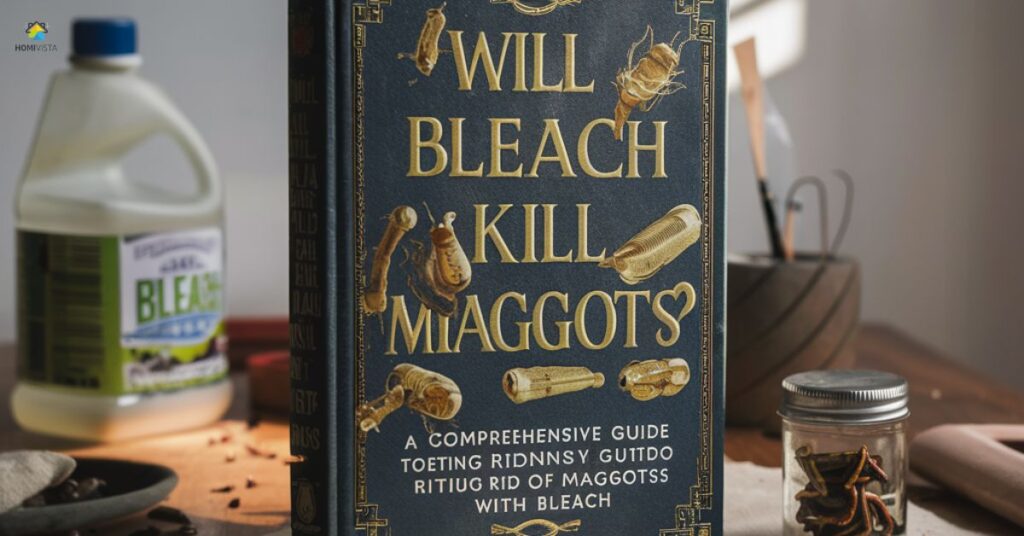Yes, bleach can effectively kill maggots. When maggots come into contact with bleach, the bleach’s chemical properties break down their cellular structure, leading to their death. It’s important to note that using bleach should be done carefully and in a well-ventilated area, as it can be harmful if inhaled or if it comes into contact with skin. Additionally, proper disposal of dead maggots and thorough cleaning of affected areas is recommended after using bleach
What are Maggots?
Maggots are the larval stage of flies and other insects belonging to the order Diptera. They are typically white or pale in color and have a cylindrical body with no legs. Maggots feed on decomposing organic matter such as rotting food, dead animals or waste material. They play a crucial role in the natural decomposition process, breaking down organic material into simpler forms.
How to Use Bleach to Kill Maggots
To use bleach to kill maggots, mix a solution of bleach and water in a spray bottle. Apply the solution directly to the maggots or the affected area. The bleach will penetrate the maggots’ bodies, causing their cells to break down and resulting in their death.
After applying the bleach solution, wait for a few minutes before removing the dead maggots with a tool or vacuum. It’s important to handle bleach carefully and follow safety guidelines, such as wearing gloves and ensuring proper ventilation.
Implementing Procedure

Following the procedure, mix bleach and water in a spray bottle, apply directly to maggots, wait, then remove dead maggots.
Locating the Maggots
Observe areas where organic matter decomposes, such as garbage bins or compost piles. They are commonly found in warm and moist environments. This includes checking under trash bags or in cracks and crevices. They can also be present in animal waste or decaying vegetation.
This can be identified by a foul odor or visual signs of decomposition. Once located, take appropriate measures to remove the maggots, such as using bleach or other insecticides and dispose of the organic matter properly to prevent further infestations.
Read this blog: Will Ammonia Kill Maggots? Effective Methods To Eliminate Maggot Infes – Trash Rite
Securing the Maggots
The procedure for securing maggots involves containing them to prevent further infestations. They can be secured by using airtight containers or plastic bags. This prevents them from spreading to other areas and causing additional problems.
This also makes it easier to dispose of them properly and hygienically. It’s important to seal the containers tightly and avoid leaks or openings that may allow the maggots to escape. Regular inspection and maintenance of waste disposal areas can also help to identify and address any maggot-related issues promptly.
Application of Bleach

The procedure for the application of bleach involves several steps to ensure effective results. They begin by diluting bleach with water according to the recommended ratio. This ensures a safe and potent solution for killing maggots.
This solution is then applied directly to the maggots or the affected area using a spray bottle or sponge. It’s important to cover all maggots thoroughly to ensure they come into contact with the bleach. After application, allow some time for the bleach to work before removing the dead maggots and cleaning the area thoroughly.
Thorough Cleaning
The procedure for thorough cleaning begins by removing any visible maggots and disposing of them properly. This includes using gloves and a tool to collect and seal the maggots in a bag for disposal. They clean the affected area with hot soapy water to remove any remaining traces of organic matter. This step is crucial in eliminating attractants that may lead to future maggot infestations. they thoroughly dry and sanitize the area to ensure a clean and hygienic environment.
Preventative Measures
The preventative measures for using bleach involve ensuring safety and efficacy. They include wearing protective gear like gloves and goggles when handling bleach to avoid skin and eye irritation. They also recommend using bleach in a well-ventilated area to minimize inhalation risks.
This is crucial to protect against potential health hazards. Additionally, following the recommended dilution ratio and application guidelines helps ensure that bleach is used effectively and safely to kill maggots and prevent further infestations.
Precautions to Take When Using Bleach
- The first precaution to take when using bleach is to wear protective gear such as gloves, goggles, and a mask.
- They recommend using bleach in a well-ventilated area to minimize inhalation risks and ensure proper ventilation.
- This is important to protect against potential health hazards associated with inhaling bleach fumes.
- It’s crucial to follow the manufacturer’s instructions and dilution ratios when preparing bleach solutions.
- They also advise avoiding mixing bleach with other chemicals or cleaning agents, as this can produce toxic fumes.
- It’s important to keep bleach out of reach of children and pets and store it in a cool, dry place.
- After using bleach, it’s essential to rinse surfaces thoroughly with water to remove any residue.
- They emphasize the importance of handling bleach safely and responsibly to prevent accidents and ensure effective cleaning.
Also read: How Should Food Workers Deter Pests From Outdoor Dumpsters? – Trash Rite
Understanding the Lifecycle of Maggots
Understanding the lifecycle of maggots is crucial for effective pest control. They begin as eggs laid by flies in suitable environments such as decomposing organic matter. This stage lasts for about 1-2 days before hatching into larvae, also known as maggots. This is when they actively feed and grow, molting several times as they develop.

After feeding for approximately 4-10 days, they enter the pupal stage, where they undergo metamorphosis. Finally, adult flies emerge from the pupae, completing the lifecycle and restarting the process by laying eggs. Bleach kills maggots effectively, making it a useful tool in pest management strategies.
Frequently Asked Questions
Does bleach kill maggots?
Yes, bleach can effectively kill maggots. When maggots come into contact with bleach, the bleach’s chemical properties break down their cellular structure, leading to their death.
Can boiling water kill maggots?
Yes, pouring boiling water over maggots can kill them. The high temperature of the water effectively destroys their bodies and prevents further infestation.
Do insecticides kill maggots?
Yes, insecticides specifically designed to target maggots can effectively kill them. These products are formulated to penetrate the maggots’ bodies and disrupt their biological processes, leading to their demise.
Will vinegar kill maggots?
Yes, vinegar can kill maggots. Its acidic nature breaks down the maggots’ bodies, causing them to die. However, vinegar may not be as effective as other methods like bleach or boiling water.
Can rubbing alcohol kill maggots?
Answer: Yes, rubbing alcohol can kill maggots upon contact. Its high alcohol content acts as a solvent that damages the maggots’ tissues, leading to their death.
Do household cleaners kill maggots?
Some household cleaners, especially those containing bleach or strong chemicals, can kill maggots. It’s essential to use these cleaners according to the manufacturer’s instructions and safety guidelines.
Can salt kill maggots?
Yes, salt can dehydrate and kill maggots. Sprinkling salt directly on maggots or mixing it with water to create a saline solution can be an effective method of extermination.
Does sunlight kill maggots?
Yes, exposure to direct sunlight can kill maggots. The heat and UV rays from the sun can dehydrate and eventually kill maggots, especially when they are exposed for an extended period.
Will lime powder kill maggots?
Yes, lime powder, also known as hydrated lime or calcium hydroxide, can kill maggots. When sprinkled over maggots, lime powder absorbs moisture from their bodies, causing dehydration and death.
Can freezing temperatures kill maggots?
Yes, freezing temperatures can kill maggots. Exposing maggots to freezing temperatures, such as placing them in a freezer, can immobilize them and eventually lead to their death due to the extreme cold.
Conclusion
The conclusion of “Will Bleach Kill Maggots? A Comprehensive Guide to Getting Rid of Maggots with Bleach emphasizes the effectiveness of bleach in eliminating maggots. They highlight that bleach can indeed kill maggots upon contact, thanks to its chemical properties that break down their cellular structure. This comprehensive guide provides step-by-step instructions on how to use bleach effectively to eradicate maggots, including dilution ratios, application methods and safety precautions.
They stress the importance of handling bleach safely and responsibly. This includes wearing protective gear such as gloves and goggles, using bleach in a well-ventilated area and following the manufacturer’s instructions. It’s crucial to note that while bleach is effective in killing maggots, it should be used judiciously and in accordance with safety guidelines to avoid potential health hazards. Here is a valuable information and practical tips for using bleach as a maggot extermination method.

Meet Harry, our seasoned home decor specialist with three years of hands-on experience. His passion lies in crafting inviting spaces that reflect your style. From cozy corners to vibrant living rooms. Harry’s keen eye for design ensures every detail enhances the overall aesthetic. Trust him to turn your home into a personalized haven, blending functionality with flair.







